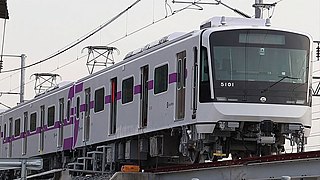
Seoul Subway Line 5 of the Seoul Metropolitan Subway, dubbed the purple line, is a long line crossing from west to the east across the Seoul National Capital Area, South Korea. It is one of two subway lines in Seoul to cross under the Han River, which is done at two points. The main line runs through to Hanam Geomdansan Station while the branch line from Gangdong Station terminates at Macheon Station. In 2019, Line 5 carried an annual ridership of 334 million or about 915,000 passengers per day.

Jongno or Jong-ro is a trunk road and one of the oldest major east–west thoroughfares in Seoul, South Korea. Jongno connects Gwanghwamun Plaza to Dongdaemun.

Seoul Subway Line 3 of the Seoul Metropolitan Subway is a rapid transit service that connects Eunpyeong District to Gangnam and southeastern Seoul. Most trains head further northwest to serve Goyang via the Ilsan Line. In 2021, the Seoul Metro operated section had an annual ridership of 295,930,000 or 810,767 passengers per day.

Seoul Subway Line 6 is a line of the Seoul Metropolitan Subway. The route connects Eunpyeong-gu and Jungnang-gu in a U-shaped manner, running through Yongsan-gu and Seongbuk-gu. It does not cross the Han River. It is mainly used to connect to the northern outskirts of Seoul and to relieve the traffic on other lines.

Seoul Metropolitan Rapid Transit Corporation (SMRT) was established in 1994 to operate the Seoul Subway lines 5, 6, 7, 8 in Seoul, South Korea.

Anguk station, also known as Hyundai E & C station (Korean: 현대건설), is a subway station on the Line 3 of the Seoul Metropolitan Subway. The station is located in the Anguk neighborhood of Jongno District, Seoul and is the nearest subway station to the Insa and Samcheong neighborhoods. The station is also near the ancient royal residence of Unhyeongung.

Insa-dong (Korean: 인사동) is a dong, or neighborhood, in Jongno District, Seoul, South Korea. Its main street is Insadong-gil, which is connected to a number of alleys that lead deeper into the district, with modern galleries and tea shops. Historically, it was the largest market for antiques and artwork in Korea.
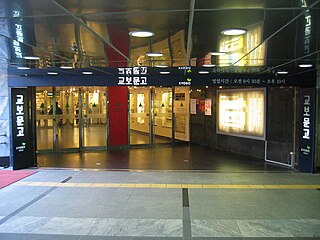
Kyobo Book Centre is the largest bookstore chain in South Korea. It has ten stores in seven cities, with the flagship Main Store, or Gwanghwamun-jeom in Seoul, which is located in the basement of the Kyobo Building, at 1 Jong-ro, Jongno-gu in Seoul's central business district.
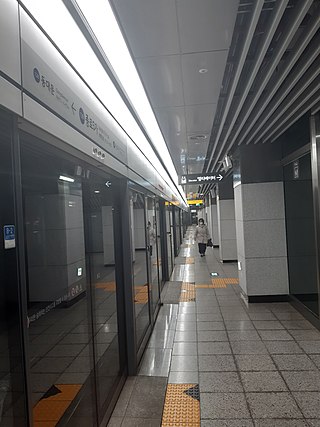
Jongno 5(o)-ga Station is a station on the Seoul Subway Line 1. It is located underneath Jongno, a major street in downtown Seoul.
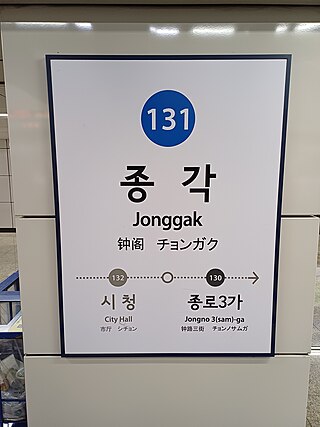
Jonggak Station is a station on the Line 1 of the Seoul Subway in South Korea. It is located on Jongno, central Seoul and comprises a large underground arcade.

Gwanghwamun Station (Korean: 광화문역) is a station on the Seoul Subway Line 5 in South Korea. It is not the closest subway station to the actual gate of Gwanghwamun, which it is named after. It is located next to the U.S. Embassy in Seoul.

Tapgol Park, formerly Pagoda Park, is a public park located at 99 Jongno, Jongno District, Seoul, South Korea. It is 1.50561 ha in area. The park was previously known as Pagoda Park until May 28, 1992.

Dongdaemun History & Culture Park station (Korean: 동대문역사문화공원) is a station on Line 2, Line 4 and Line 5 of the Seoul Metropolitan Subway. It is named for the nearby Dongdaemun History & Culture Park. The huge Dongdaemun Market district is centered on this station and Dongdaemun Station, located to the north across Cheonggyecheon.
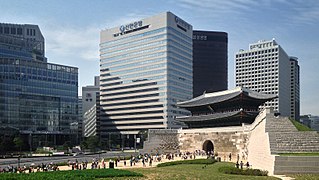
Jung District is one of the 25 districts of Seoul, South Korea.
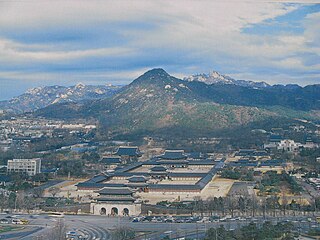
Jongno District is a district in Downtown Seoul, South Korea. It is the historic center of Seoul, and contains the Joseon-era royal palace Gyeongbokgung and the former presidential residence, the Blue House.

Jamsil Station is an underground station on Line 2 and Line 8 of the Seoul Metropolitan Subway. Lotte World is continuous with the Line 2 station. The station is also called Songpa-gu Office Station (송파구청역), due to the proximity of the office building.

Express Bus Terminal Station is a station on Seoul Subway Line 3, Line 7, and Line 9. The stations are located in the Greater Gangnam Area, Banpo-dong, Seocho District, Seoul, Korea.

Gyeongbokgung station (Korean: 경복궁역) is a subway station on Line 3 of the Seoul Metropolitan Subway. It is the subway station nearest to the Gyeongbokgung Palace. The station is also near the Government Complex–Seoul, the National Police Agency of South Korea, and other administrative buildings in the neighborhood.
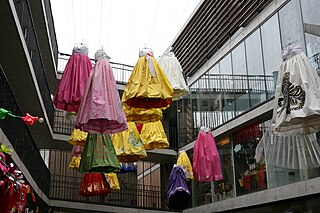
Seoul, the capital of South Korea, has many shopping areas and markets throughout the city. Famous ones include Myeong-dong, Cheongdam-dong, the Hongdae area, and the Dongdaemun and Namdaemun markets.
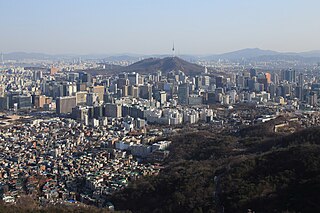
Downtown Seoul, also known as Seoul Central Business District or Sadaemun-An is traditional city center and central business district of Seoul, located through Gwanghwamun of Jongno District and Seoul Station of Jung District along the Sejong-daero and Jong-ro. For its time-honored and unique geographic status in Seoul, the downtown is usually just called the Central Business District, or sometimes Gwanghwamun Business District for the landmark 'Gwanghwamun' at the heart of it.























